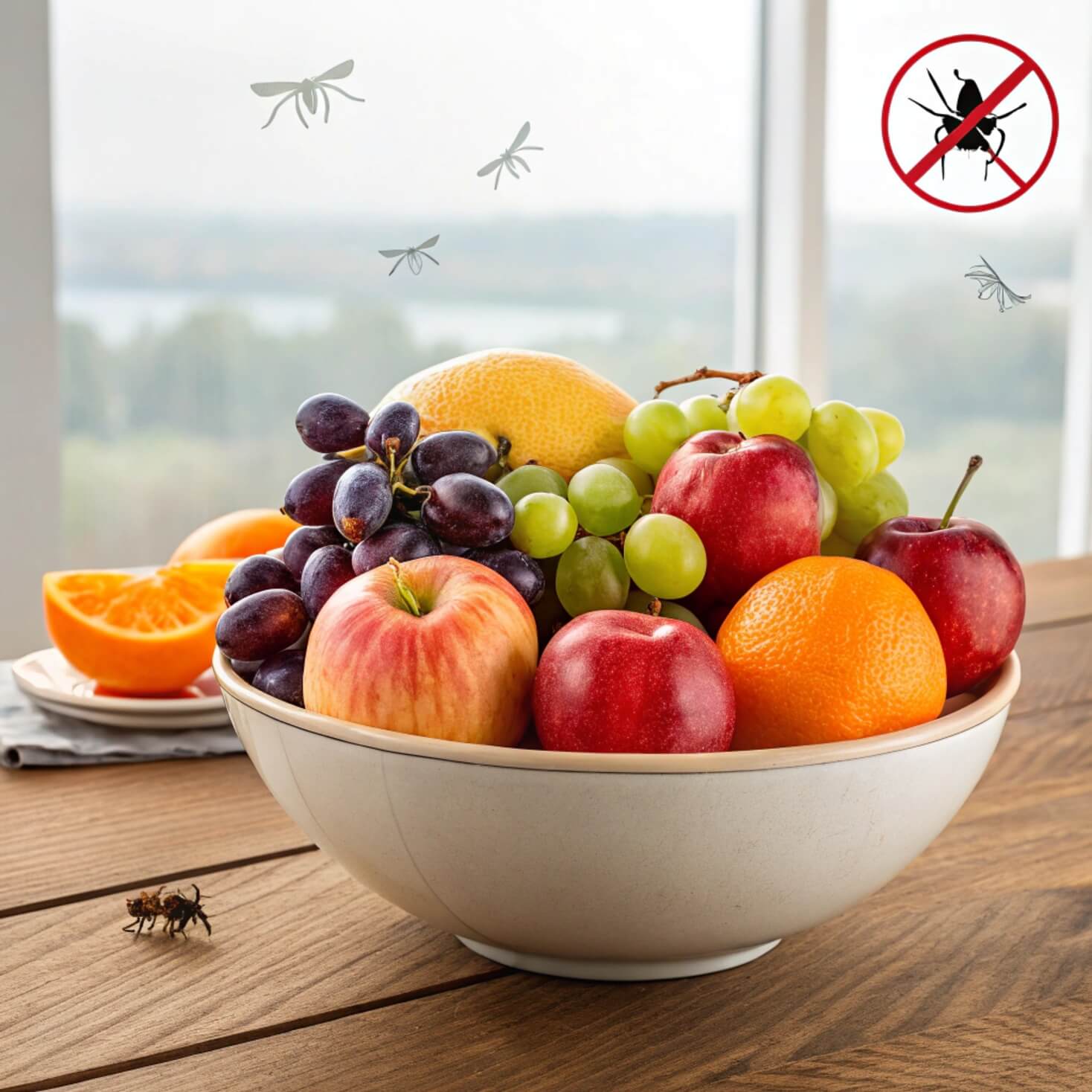Fruit flies in your house may quickly escalate from a bit of irritation to a serious issue. These little bugs proliferate swiftly and appear unexpectedly, lurking in your fruit bowl, kitchen sink, and trashcan. Mrs. Johnson of Ohio recalled spending weeks fighting fruit bugs after harvesting a banana crop. Mr. Rivera of Arizona said he didn’t understand why fruit flies kept returning to his spotless kitchen until he discovered they were spawning in his sink drain.
Are fruit flies swarming your kitchen despite your best cleaning efforts? Do they seem to multiply overnight, regardless of what you do? Have you tried store-bought medicines but had little success? You are not alone, and there are practical answers to this common household problem.
To get rid of fruit flies, use a simple trap made of apple cider vinegar and dish detergent in a small bowl covered in plastic wrap with little holes poked through it. Store fruits in the refrigerator and immediately clean up spills to remove food sources. Clean the drains with baking soda and vinegar, then flush with hot water. Replace waste bags regularly and ensure windows have enough screens to solve reoccurring difficulties.
What are Fruit Flies, and why do they invade your home?
Fruit flies are tiny insects that are around 1/8 inch long. They have tanned or brownish skin and bright red eyes. These pests belong to the Drosophilidae family, with Drosophila melanogaster being the most common species seen in homes. Fruit flies are much smaller than regular house flies and may get through small openings like window screens and door gaps.
The perfume of ripe fruits and vegetables and fermentation attract these insects to your home. A female fruit fly may lay up to 500 eggs at a time, which hatch into larvae within 24-30 hours. The life cycle from egg to adult takes around 8-10 days, which explains why an infestation may spread quickly. Fruit flies live on fruits and proliferate in moist areas with organic waste, such as sewers, trash cans, empty bottles, and damp mops.
How to Identify Fruit Flies vs. Other Small Flying Insects
Before you treat your pest problem, be sure you’re dealing with fruit flies, not other similar insects like gnats or drain flies. Fruit flies are often light brown or tanned, with red eyes. They hover around fruits and food. Fungus gnats are black and are often observed around houseplants. Drain flies have moth-like wings and spend much of their time around drains and pipes.
| Insect | Appearance | Where Found |
|---|---|---|
| Fruit Flies | Tan/brown with red eyes | Near fruits, food, kitchen areas |
| Fungus Gnats | Black with long legs | Potted plants, soil |
| Drain Flies | Moth-like with fuzzy wings | Bathroom/kitchen drains |
DIY Vinegar Traps: The Most Effective Home Remedies
The most dependable approach for catching fruit flies uses the fermented scent of vinegar as bait. These traps are simple to construct, use just ordinary home objects, and may be operational within hours. For the best results, distribute several around your house in trouble areas.
Apple Cider Vinegar and Dish Soap Trap
This classic trap is still popular since it’s pretty efficient and employs stuff that most people already have at home. The delicious fragrance of apple cider vinegar attracts fruit flies, but dish soap reduces surface tension, causing flies to sink and die when they land.
Apple cider vinegar – Dish soap – Small bowl – Plastic wrap – Rubber band – Toothpick
- Fill a small bowl with about 1/4 cup of apple cider vinegar.
- Add 3-5 drops of dish soap and stir gently.
- Cover the bowl tightly with plastic wrap.
- Secure the plastic wrap with a rubber band around the bowl’s edge.
- Use a toothpick to poke 5-10 small holes in the plastic wrap.
- Place the trap in areas where you’ve seen fruit flies.
Pro Tip: Before constructing the trap, slightly warm the vinegar in the microwave. The heat promotes fragrance release, which attracts fruit flies.
White Vinegar Alternative Method
Do not have apple cider vinegar? Regular white vinegar is equally effective; however, it is less enticing to fruit flies. Add a teaspoon of sugar to the mixture to boost its effectiveness and create a sweeter scent. The sugar-vinegar combination has the stench of decaying fruit, which fruit flies like.
Follow the same steps as the apple cider vinegar trap, but add one teaspoon of sugar and 1/4 cup of white vinegar before adding the dish soap. The sugar dissolves in the vinegar, boosting its appeal without reducing the trap’s effectiveness.
No-Vinegar Options
If you don’t have vinegar or don’t want to use it, there are many adequate replacements. Red wine, fruit juice, or even bits of particularly ripe fruit may be effective bait. The secret is to create a trap that flies may enter but have difficulty escaping and include an element that causes them to drown.
- Pour 1/4 cup of red wine, beer, or fruit juice into a small container.
- Add a couple of drops of dish soap.
- Cover with plastic wrap and poke holes, or leave uncovered if using a container with a small aperture.
- Locate near fruit fly hotspots.
How to Get Rid of Fruitflies in Drains
Kitchen and bathroom drains are ideal breeding grounds for fruit flies. The damp environment and organic matter buildup provide excellent conditions for them to lay eggs and proliferate. To get rid of fruit flies in drains, you must remove the biofilm that allows them to proliferate.
Boiling Water Flush Method
The most straightforward approach to kill fruit fly larvae in drains is to boil water. The heat destroys eggs and larvae, while the water’s power helps dislodge organic deposits where they reproduce. For best results, do this treatment every day for at least a week.
- Boil at least half a gallon of water.
- Carefully pour the hot water straight down the drain.
- Allow it to settle for 30 seconds before running cold water.
- Repeat the method every day until no more fruit flies emerge.
Warning: To minimize damage to your PVC pipes, use hot but not boiling water. Boiling water is safe for metal pipes.
Baking Soda and Vinegar Deep Clean
This approach produces a bubbling chemical reaction that helps break the sticky biofilm in drains where fruit flies breed. The fizzing motion cleans nooks that the brush alone cannot reach.
- Pour 1/2 cup baking soda into the drain.
- Next, add 1 cup of white vinegar.
- Cover the drain with a stopper or plate for 5 to 10 minutes.
- Pour boiling water down the drain to flush.
- Repeat twice weekly until the issue is resolved.
Enzymic Drain Cleaners
Enzymatic drain cleaners are an efficient solution for recurring drain infestations. Instead of harsh chemicals, these biological cleaners use natural enzymes to break down organic material in regions where fruit flies reproduce. They perform especially effectively with drains that haven’t been cleaned regularly.
Follow the package instructions for application, which usually include pouring a certain amount down the drain and letting it work overnight. The enzymes work for many hours, breaking down dirt that other cleaning methods may not be able to remove.
How to Get Rid of Fruit Flies in Your Kitchen
In most instances, fruit fly infestations start in the kitchen. Kitchens have a range of food sources and breeding grounds, such as fruit bowls, garbage cans, and food preparation areas. A comprehensive plan that tackles all potential trouble areas yields the best results.
Refrigerate fruits and vegetables.
The most effective preventive measure is to chill ripe fruits and vegetables. Fruit flies can sense gases released by ripening food across vast distances, and storing food in the refrigerator eliminates their primary attraction and breeding site.
For fruits that do not need to be refrigerated (such as bananas), use fruit storage containers with tight-fitting lids or mesh food covers to allow air circulation while keeping fruit flies at bay. Check the vegetables regularly and reject anything that seems overripe or rotting.
Clean Garbage Disposals and Trash Cans
Garbage disposal devices collect food particles, which deteriorate and attract fruit flies. To clean your disposal, put ice cubes through it to remove dirt from the blades. Then, mix lemon peels with salt to deodorize and remove any leftover residue.
To thoroughly clean trash cans, use hot, soapy water and disinfectant. Pay particular attention to the bottom of the lid and the rim. After cleaning, spray with white vinegar and wipe dry. During an infestation, use drawstring trash bags and dispose of garbage more often.
Before you put a new bag in your clean trash can, insert a piece of paper towel soaked in white vinegar at the bottom. This creates an environment that fruit flies avoid, preventing them from reproducing in small spills.
Clean sticky residues and spills.
Fruit flies need a small amount of organic material to reproduce. The sticky residue on bottle lids spilled juice, and food particles in sink crevices provide excellent breeding conditions. Regularly wipes down countertops with a vinegar-water solution during an infestation, giving special attention to areas around the sink, stove, and cooking surfaces.
Don’t forget to inspect less apparent areas like the seal surrounding your refrigerator door, the drip pan under the refrigerator, and the bottoms of fruit dishes. These areas often include sticky residues that aid fruit fly breeding.
How to Get Rid of Fruit Flies in Bathroom and Other Damp Areas
Bathrooms might seem unusual for fruit flies, but these pests are attracted to any moist area with organic matter. The dampness combined with hair and other organic residues in drains provides an ideal breeding ground. Many people are surprised to find fruit flies in bathrooms, but it’s pretty.
Tackling Bathroom Drain Infestations
Bathroom drains collect hair, skin cells, and product residue, creating a biofilm where fruit flies lay eggs. Unlike kitchen drains, bathroom drains often have more complex traps and may require different treatment approaches.
- Remove the drain cover and clean it thoroughly with hot, soapy water.
- Use a drain brush or an old toothbrush to scrub the visible parts of the drain.
- Pour 1/2 cup of salt down the drain, followed by 1/2 cup of baking soda.
- Add 1 cup of white vinegar and let the mixture foam for 10 minutes.
- Flush with at least 2 quarts of boiling water.
- Pay special attention to hair clogs for shower drains that can harbor fruit fly larvae.
- Pro Tip: First, use a drain snake or zip tool to remove hair clogs before applying chemical treatments for shower and bathtub drains. This makes the cleaning solutions much more effective by allowing them to reach the biofilm where fruit flies breed.
Addressing Moisture Problems
Excess moisture in bathrooms creates conditions that fruit flies love. Reducing humidity and standing water eliminates breeding sites and makes the area less attractive to these pests.
- Fix any leaking pipes or faucets promptly.
- Use exhaust fans during and after showers to reduce humidity.
- Wipe down shower walls and floors after use to reduce standing water.
- Keep shower curtains open to dry rather than bunched up where moisture collects.
- Regularly wash bath mats and hang them to dry completely between uses.
- Empty and clean toothbrush holders and soap dishes where water collects.
- Consider using a dehumidifier in naturally damp bathrooms, especially during humid summer when fruit fly problems are worst. Keeping bathroom humidity below 50% significantly reduces the attractiveness of the environment for fruit flies.
How to Get Rid of Fruit Flies in Houseplants
Houseplants sometimes become breeding grounds for fruit flies, especially if you overwater them or the soil contains decaying organic matter. Many people mistake fungus gnats for fruit flies in plants, but true fruit flies can also infest potted plants if there’s rotting plant material or overripe fruit nearby.
Soil Management Techniques
Potting soil’s moist, organic environment can attract fruit flies, particularly if plants are overwatered or have decomposing leaves on the soil surface. Proper soil management is key to eliminating and preventing infestations.
- Remove the top inch of soil from affected plants and replace it with fresh potting mix.
- Add a layer of sand or aquarium gravel on top of the soil to prevent flies from accessing the soil to lay eggs.
- Let the soil dry out between waterings – most houseplants prefer this anyway.
- Remove dead leaves and plant debris regularly.
- Check for and remove any fallen fruit or plant parts that might be decaying in the pot.
Natural Deterrents for Plants
Several natural substances can deter fruit flies from houseplants without harming them. These solutions work well as both treatment and prevention methods.
- Cinnamon powder: Sprinkle a thin layer on the soil surface. Cinnamon has natural antifungal properties and repels fruit flies.
- Diatomaceous earth: This powder damages the exoskeleton of insects that come in contact with it. Sprinkle a thin layer of soil.
- Neem oil solution: Mix two teaspoons of neem oil with 1 quart of water and a few drops of mild dish soap. Spray soil surface and bottom of pots weekly.
- Yellow sticky traps: Place these near but not touching plants to catch adult flies.
Warning: When using any treatment on houseplants, first test on a small area to ensure the plant doesn’t react negatively. Some sensitive plants may not tolerate specific treatments.
How to Get Rid of Fruit Flies Fast: Emergency Tactics
When you need immediate results, perhaps before hosting guests or simply because you’ve reached your limit with these pests, these rapid-response methods can dramatically reduce fruit fly populations within 24-48 hours.
The Vacuum Method
Nothing beats direct removal with a vacuum cleaner to reduce adult fruit fly numbers quickly. This method won’t address the underlying infestation but provides immediate visual relief from flying pests.
- Attach the hose extension to your vacuum cleaner.
- Turn on the vacuum and hold the nozzle near clusters of fruit flies without touching surfaces.
- The suction will pull in the flies without harming your furniture or countertops.
- Focus on where flies gather: near fruit bowls, garbage cans, and windows.
- For thorough elimination, vacuum the area twice daily for two days.
- After vacuuming, remove the vacuum bag and seal it in plastic before disposal to prevent flies from escaping.
Fan and Sticky Trap Combination
This clever method uses air movement to direct fruit flies into sticky traps for rapid capture. It’s particularly effective in smaller kitchens or bathrooms where airflow can be controlled.
- Place a small fan on one side of the infested area.
- On the opposite side, hang or place commercial sticky fly traps.
- Turn the fan low-speed, creating gentle airflow toward the sticky traps.
- Fruit flies caught in the airstream will be pushed toward and stick to the traps.
- For best results, do this in the evening when fruit flies are most active.
Electronic Bug Zappers
While not explicitly designed for fruit flies, modern indoor electronic insect traps can quickly reduce fruit fly populations. These devices use UV light to attract insects and trap or eliminate them.
Place the electronic trap near fruit fly hotspots but away from food preparation areas. Most effective models use a fan to draw insects in rather than a zapping mechanism, making them quieter and more hygienic for kitchen use. Run the trap overnight when flies are most active and room lighting is minimal, making the UV light more attractive to the insects.
For maximum effectiveness, turn off all other lights in the area when using electronic traps. This makes the UV light more attractive to the flies. Place the trap about 3-5 feet off the ground for best results.
How to Prevent Fruit Flies from Coming Back: Long-Term Solutions
After successfully eliminating a fruit fly infestation, preventive measures are crucial to avoid future problems. These persistent pests can return quickly if conditions remain favorable for them. The key to permanent fruit fly control is consistent household habits that create an environment where they cannot thrive.
Kitchen Management Practices
Most fruit fly problems start in the kitchen, making this area your first line of defense. Small changes in handling food and waste can make a significant difference.
- Store ripening fruits and vegetables in the refrigerator or sealed containers.
- Wash produce when you bring it home to remove any potential eggs or larvae.
- Use produce storage bags or containers that allow air circulation while keeping flies out.
- Clean up spills immediately, especially fruit juice, wine, or other sweet liquids.
- Rinse all beverage containers before recycling and store recyclables outside if possible.
- Use trash cans with tight-fitting lids and empty them regularly, at least every other day.
- Run the garbage disposal daily and clean it weekly with ice, salt, and lemon peels.
Fruit fly issues sometimes worsen at particular periods of the year. Awareness of seasonal trends allows you to take preventative steps when most required.
Fruit fly season peaks in the summer and early autumn, owing to higher temperatures and more fresh fruits in households. During these months, be very cautious about fruit storage and kitchen cleanliness. Gardening and composting should be done as far away from home entrances since they might serve as breeding grounds for interior pests.
When returning from farmers’ markets or supermarket shopping during peak season, thoroughly check the vegetables before bringing them inside. Place sensitive products like bananas, tomatoes, and peaches in the refrigerator for the first day to destroy any eggs or larvae before transferring them to a fruit bowl.
What Attracts Fruit Flies
- Ripening fruits and vegetables
- Spilled juice, wine, or beer
- Moist food scraps in the trash
- Dirty drains with organic buildup
- Damp mops and cleaning tools
- Overwatered houseplants
- What Repels Fruit Flies
- Clean, dry surfaces
- Potent essential oils (basil, lemongrass)
- Regularly emptied trash cans
- Clean drains
- Good ventilation
- Properly stored food
How do I tell the difference between fruit flies and gnats?
Fruit flies are often light brown or tan with red eyes and enjoy kitchens and fruits. Fungus gnats are black, smaller, and have longer legs. They usually linger about houseplants and dirt. Fruit flies move slowly and purposefully, while gnats fly frantically. Under intense light, fruit flies seem spherical, while gnats resemble mosquitos.
Why do I have fruit flies in winter when I don’t have fresh fruit?
Winter fruit fly outbreaks often originate from concealed sources. Look for neglected potatoes or onions in cupboards, plant soil, trash disposals, floor drains, and recycling containers. If fruit flies locate wet organic debris, indoor heating helps them breed all year. Houseplants watered more regularly throughout the winter owing to dry heating might also serve as breeding grounds.
How long does it take to completely get rid of fruit flies?
You should observe a considerable decrease after 3-5 days with frequent trapping and cleaning procedures. Complete removal typically takes 1-2 weeks since you must disrupt the breeding cycle by removing adult flies and developing larvae. Persistence is essential since even missing a single breeding location may enable the population to recover swiftly.
Is it true that fruit flies can come from store-bought produce?
Fruit flies and their eggs may hitchhike on store-bought vegetables, particularly organic or pesticide-free stuff from farmers’ markets. Females are drawn to ripen fruit and deposit eggs on its surface. These eggs are small (approximately 0.5mm) and practically undetectable, making them simple to carry home unintentionally.
Can fruit flies make you sick?
Unlike other insects, fruit flies are not direct disease vectors, although they may transport germs from decomposing debris to food surfaces. Research suggests they may carry and spread E. coli, Salmonella, and Listeria. They do not bite people; therefore, their primary health danger is polluting food preparation surfaces rather than directly biting or stinging.
Eliminating fruit flies requires a multifaceted strategy targeting adult flies and breeding places. Success is achieved by combining rapid removal tactics with long-term preventative strategies. While these pests may seem unstoppable, their basic biochemistry makes them susceptible to the correct approaches.
Begin by thoroughly cleaning all possible breeding places, including sewers and locations where food is kept or cooked. Set up many vinegar traps around your house to capture adult flies. Maintain proper food storage and waste management practices, such as refrigerating ripe fruits and frequently taking out the garbage. Finally, maintain regular cleaning routines to avoid recurring infestations.
Remember that perseverance is essential. A female fruit fly may lay hundreds of eggs, which hatch into adults in a little over a week. Breaking this reproductive cycle demands at least two weeks of consistent work. Even if you believe the issue has been resolved, maintain preventative measures for another week to guarantee no new flies appear.
Following the steps outlined in this tutorial will reduce present fruit fly infestations and create an environment where these annoying insects are unlikely to return. Your house will be more comfortable, your food safer, and your mind at ease.
Final Tip: Set a periodic reminder on your calendar to inspect probable fruit fly breeding locations throughout the spring and summer months, when infestations are most frequent. This preventive method may detect issues before they escalate into full-fledged infestations.











